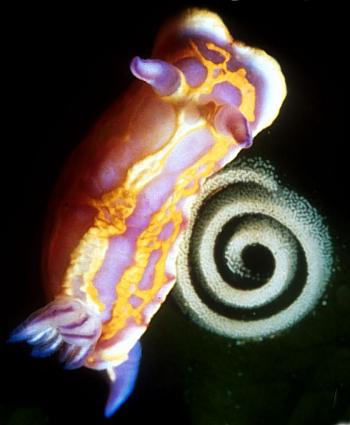
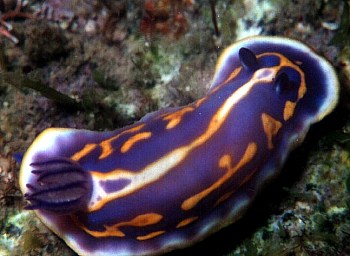
Chromodoris britoi
Ortea & Pérez, 1983
Order: NUDIBRANCHIA
Suborder: DORIDINA
Superfamily: EUDORIDOIDEA
Family: Chromodorididae
DISTRIBUTION
Mediterranean and Eastern Atlantic.
PHOTO
UPPER: Naples, Italy. Photo: Guido Villani
LOWER: Bay of Algeciras (Strait of Gibraltar, Southern Spain), Size: 20 mm., Depth: 20 m. December, 2000 Photo: Alma Sánchez
See Angel Valdes' message discussing this species and the similarly coloured C. binza, C. clenchi and C. neona.
Reference:
• Ortea, J., Valdés, A. & Espinosa, J. (1994) North Atlantic nudibranchs of the Chromodoris clenchi colour group (Opisthobranchia: Chromododorididae). Journal of Molluscan Studies, 60: 237-248.
Rudman, W.B., 2000 (October 10) Chromodoris britoi Ortea & Pérez, 1983 . [In] Sea Slug Forum. Australian Museum, Sydney. Available from http://www.seaslugforum.net/find/chrobrit
Related messages
Re: Chromodoris britoi from French Mediterranean
September 3, 2008
From: Dominique Horst

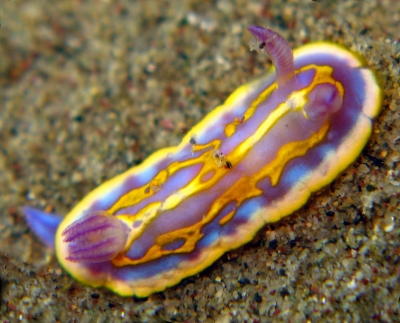
Concerning message #21844:
Hi Bill,
Thanks for your quick reply. On the following photo, the small animals involved are clearly visible. They look like crustaceans but I'm not able to identify them.
Locality: Cannes, 6 m, France, Mediterranean sea, 27 August 2008, muddy. Length: 10 mm. Photographer: Dominique Horst.
Kind regards,
Dominique
dominique.horst@wanadoo.fr
Horst, D., 2008 (Sep 3) Re: Chromodoris britoi from French Mediterranean. [Message in] Sea Slug Forum. Australian Museum, Sydney. Available from http://www.seaslugforum.net/find/21850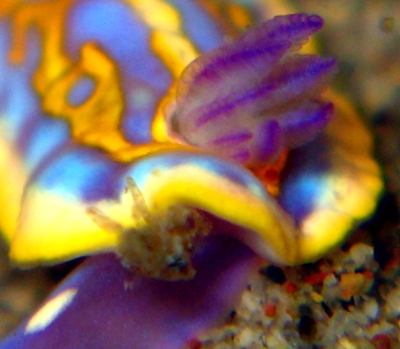
Thanks Dom,
It's easy to see why this chromodorid was so uncomfortable.
Best wishes,
Bill Rudman
Chromodoris britoi from French Mediterranean
August 29, 2008
From: Dominique Horst

Hi Bill,
I think this is Chromodoris britoi. We found it on the sand and mud during our last night dive and its beautiful colours appeared in the light. It was very stressed because it was being attacked by a small worm and crustaceans. I suppose the light was attractive for these small animals.
Locality: Cagnes, 6 m, France, Mediterranean sea, 27/08/2008. Length: 10 mm. Photographer: Dominique Horst.
After a few minutes the dorid seems to "jump" in the current to move away. It's not the first time I've observed this behaviour.
Kind regards,
Dom.
dominique.horst@wanadoo.fr
Horst, D., 2008 (Aug 29) Chromodoris britoi from French Mediterranean. [Message in] Sea Slug Forum. Australian Museum, Sydney. Available from http://www.seaslugforum.net/find/21844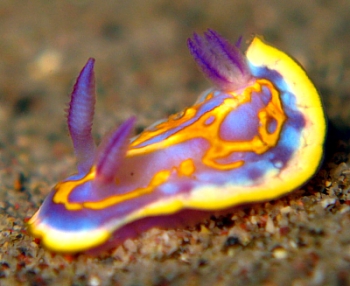
Dear Dom,
Thanks for the interesting behavioural note. Certainly in the upper photo it looks as though some animal has crawled up under the mantle and is clearly 'annoying' the chromodorid. Lifting its mantle skirt up like this could easily allow it to catch a current and drift away.
Angel Valdes [message #3157] suspects that this species and the Caribbean Chromodoris binza are probably the same.
Best wishes,
Bill Rudman
Chromodoris britoi from the Azores islands
April 18, 2008
From: David Abecasis
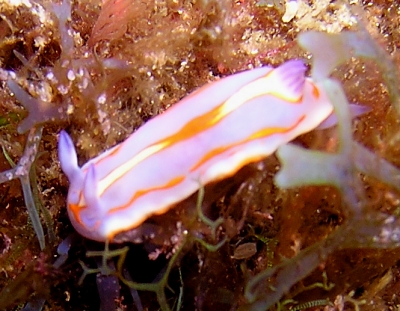
Concerning message #20916:
Hello Bill,
I'm sending you some pictures of what I believe is Chromodoris britoi. After looking in your forum I believe this is the first record for Atlantic islands.
Locality: Azores islands, 12, Portugal, Atlantic Ocean, 23 May 2007, Rocky bottom. Length: 2 cm.
Best regards,
David Abecasis
davidbecas@netcabo.com
Abecasis, D., 2008 (Apr 18) Chromodoris britoi from the Azores islands. [Message in] Sea Slug Forum. Australian Museum, Sydney. Available from http://www.seaslugforum.net/find/21535
Dear David,
It's good to get more records of this species. As you will see in an earlier message [#3157] there is some doubt about just how many species there are with this colour pattern in the Atlantic. Gosliner has suggested C. britoi and C. clenchi from the Caribbean are the same while Angel Valdes feels that C. britoi is the same as the Caribbean C. binza. Whatever turns out to be the correct answer, the presence of C. britoi in the Azores suggests a link to a Caribbean species would not be that surprising.
I have checked with a recent checklist of Spanish species (Cervera et al, 2006) and they have a number of records of this species from the Azores, and also from other Atlantic islands closer to the Afro-European coast.
-
Cervera, J. L., Calado, G., Gavaia, C., Malaquias, M. A. E., Templado, J., Ballesteros, M., García-Gómez, J. C., & Megina, C. (2006) An annotated and updated checklist of the opisthobranchs (Mollusca: Gastropoda) from Spain and Portugal (including islands and archipelagos). Boletín Instituto Espanol de Oceanografía 20: 1-122.
Best wishes,
Bill Rudman
Chromodoris britoi from mediterranean Spain
October 11, 2007
From: Jordi Regàs

Dear Dr. Rudman
Here a picture with some detail on the rhinophores and the gills of what I first classified as a Chromodoris krohni. After reading the forum I think now it's Chromodoris britoi.
Locality: L'illa, Tossa de Mar, Costa Brava, 18 meters, Girona, Spain, Mediterranean Sea, 12 September 2007. Length: 15 mm. Photographer: Jordi Regàs.
Best regards,
Jordi Regàs
jordiregas@gmail.com

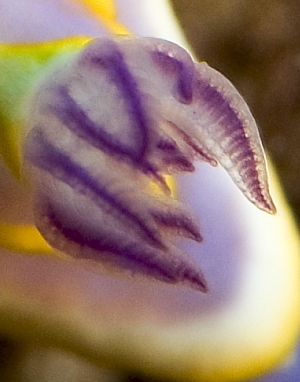
Dear Jordi,
I agree that this is C. britoi. The white marking on the rhinophores, and the dark blue lines on the gills are both found in that species but not in C. krohni. Also C. krohni has a white border around the edge of the foot which seems absent in your animals. Thanks for these photos and the others in your separate messages on C. luteorosea and C. luteopunctata. It would be good to get photos of them feeding on their preferred sponges, and laying eggs, so when you are looking at and photographing these animals, keep in mind that we know very little about their biology and natural history, and good photos can give us very valuable clues about their natural history.
Best wishes,
Bill Rudman
Chromodoris britoi from French Mediterranean
June 27, 2007
From: Sylvain Le Bris
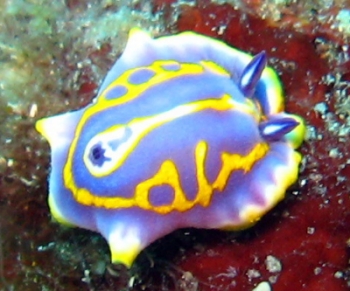
Dear Bill
Here's a picture of a chromodorid from France. Is it Chromodoris britoi?
Locality: Cap caveau, Marseille, 25m, France, Mediterranean, 23 June 2007. Length: 2cm. Photographer: Sylvain Le Bris.
Thanks
Sylvain Le Bris
sylvain.lebris@freesbee.fr
Le Bris, S., 2007 (Jun 27) Chromodoris britoi from French Mediterranean. [Message in] Sea Slug Forum. Australian Museum, Sydney. Available from http://www.seaslugforum.net/find/20069Dear Sylvain,
Yes this is C. britoi. As you will see from earlier messages, there are similarities in color between this species and C. krohni. One simple difference, which seems to hold true in all the photos on the Forum, is that in C. britoi, the rhinophores have a white line down the posterior side of the rhinophores, while in C. krohni the rhinophore clubs are uniformly deep blue or purple with a white tip.
Best wishes,
Bill Rudman
Chromodoris britoi from Mediterranean France
September 5, 2003
From: S. Lormant
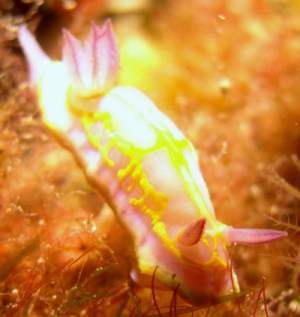
Can you tell me the name of this sea slug.
I saw it the last week (August 2003) at Cerbere on the France - Spanish border on the Mediterranean coast.
thank you
S. Lormant
stephlormant@aol.com
Lormant, S., 2003 (Sep 5) Chromodoris britoi from Mediterranean France. [Message in] Sea Slug Forum. Australian Museum, Sydney. Available from http://www.seaslugforum.net/find/10895Dear M. Lormant,
This is Chromodoris britoi. If you look at the Fact Sheet and the other messages attached below yours on this page you will find some information on this species
Best wishes,
Bill Rudman
Chromodoris britoi from French Mediterranean
July 29, 2003
From: Marina Poddubetskaia
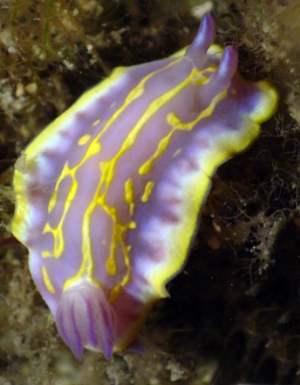
Dear Bill,
Here are some Chromodoris britoi from Cerbere. This species is similar to Chromodoris krohni. As discussed last year, the main characteristic to distinguish them is the presence of a dark yellow or orange spot in the centre of the median line in C. britoi. This distinctive feature is well visible in second photo. For comparison, the lower right photo is of Chromodoris krohni and it hasn't any darker spot.
All are from Cerbere, France, Mediterranean coast:
Upper Right Photo: C. britoi July 09, 2003. Location : Site: L'Ocell. Depth: 15m. Size: 20mm
Lower Left Photo: C. britoi July 10, 2003. Site: La Ramere. Depth: 15m. Size: 10-12mm
Lower Right Photo: C. krohni July 13, 2003. Site : Les Chambres. Depth: 8m. Size: 12-14mm
Photos: Marina Poddubetskaia - Nembro website
Cordially,
Marina.
nembro@nembro.info
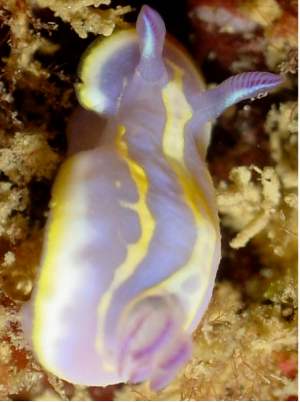

Thanks Marina,
I guess by 'dark spot' you mean the area where the pigment seems darker or more intense in the centre of the mantle. I think probably a more reliable external character would be the colour of the gills and rhinophores. In C. britoi the rhinophore clubs seem to be translucent white with a white line up the posterior midline, with a bluish purple line on either side and a third up the anterior midline. In some animals with a more intense blue pigmentation, the rhinophores appear blue but the posterior white line is still visible. The gills are also translucent with a bluish purple line up the inside and outside edge. In C. krohni both the gills and rhinophores seem to have a more uniform pigmentation, animals such as yours having a uniform translucent wine-red tinge wit some white speckling and in other animals illustrated on the Forum the colour becomes a more intense purplish red or even dark blue, but it is always a single colour.
I have included some close-ups of your photo of C. krohni in a separate message to show distinctive colour features of that species.
Best wishes,
Bill Rudman
Chromodoris britoi from Spain
January 18, 2001
From: Alma Sánchez
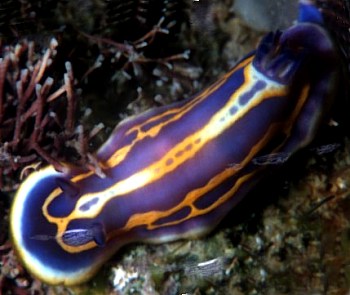

Dear Dr. Rudman:
Here are two photos of Chromodoris britoi for your Forum.
Data:
(UPPER): Bay of Algeciras (Strait of Gibraltar, Southern Spain), Size: 25 mm., Depth: 18 m. December, 2000.
(LOWER): Bay of Algeciras (Strait of Gibraltar, Southern Spain), Size: 20 mm., Depth: 20 m. December, 2000.
Best wishes,
Alma Sánchez.
Dear Alma,
Thanks very much for these nice photos. Any others you have of Mediterranean or Atlantic nudibranchs would be welcome.
Best wishes,
Bill Rudman.
Chromodoris britoi from Spain
October 26, 2000
From: Daco
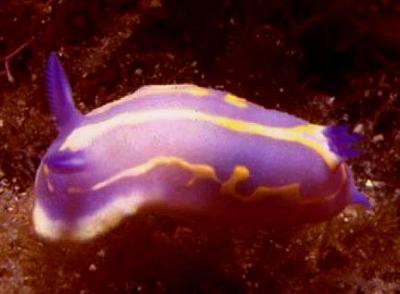
Dear Dr. Rudman,
I want send to you another photo of Chromodoris britoi for your Forum.
Size: ~1 cm
Depth: 10 m
Date: 15 July 2000 8:00 GMT
Divesite: Punta de Santa Anna, Blanes, (Costa Brava, Spain)
You can see more at: http://www.marenostrum.org/opistobranquios/cbritoi/
Cordialment
Daco
daco@iponet.es
Dacosta, J. Mª., 2000 (Oct 26) Chromodoris britoi from Spain. [Message in] Sea Slug Forum. Australian Museum, Sydney. Available from http://www.seaslugforum.net/find/3241Thank you Daco,
It is a beautiful animal.
Bill Rudman.
